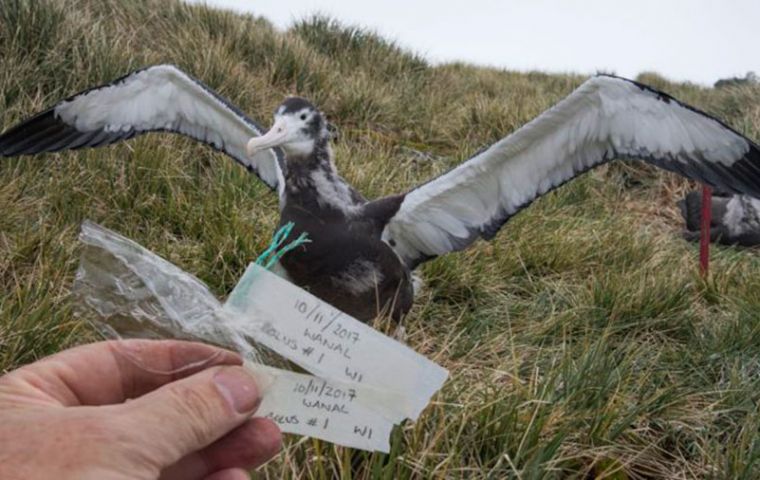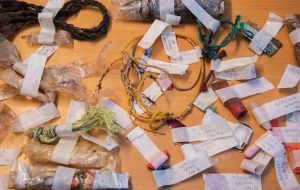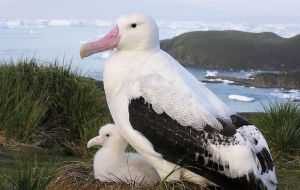MercoPress. South Atlantic News Agency
Plastic pollution continues to reach sub-Antarctic islands
 Plastic debris collected from the nest of a wandering albatross on Bird Island. (Pic BAS)
Plastic debris collected from the nest of a wandering albatross on Bird Island. (Pic BAS)  Plastic debris has been collected at Bird Island and Signy Island for the last three decades (Pic BAS)
Plastic debris has been collected at Bird Island and Signy Island for the last three decades (Pic BAS)  Items ingested by wandering albatrosses and giant petrels were primarily food-related wrapping that had been packaged in South America (Pic BAS)
Items ingested by wandering albatrosses and giant petrels were primarily food-related wrapping that had been packaged in South America (Pic BAS) Food wrapping, fishing gear and plastic waste continue to reach the Antarctic. Two new studies into how plastic debris is reaching sub-Antarctic islands are published in the journal Environment International.
New findings include analyses of some of the longest continuous datasets in the world on plastics ingested by seabirds and washed up on beaches, and insights into where this plastic originates. They also highlight the ongoing prevalence of plastic in the Polar Regions, its impact on the environment and the animals that inhabit these remote areas.
Scientists from British Antarctic Survey (BAS) have systematically collected marine debris washed up on the beaches of Bird Island (South Georgia) and Signy Island (South Orkneys) over three decades. Their findings reveal an increase in the amount of debris collected. Over 10,000 items were recovered, the majority of which were plastic.
Lead author Dr Claire Waluda, a marine ecologist at BAS, says: “While we found an increase in the quantity of beached plastic debris, recent surveys have shown increasing numbers of smaller pieces. This might be due to the breakdown of larger pieces of plastic which have been in the Southern Ocean for a long time.
“It’s not all bad news. With the amount of plastic recovered on beaches peaking in the 1990s, our study suggests that the measures to restrict the amount of debris entering the Southern Ocean have been successful, at least in part. But more still needs to be done. By putting our data into oceanographic models we will learn more about the sources and sinks of plastic waste and how it is transported into and around the Southern Ocean.”
A second BAS-led study used seabirds as sentinels of plastic pollution, due to their natural tendency to consume indigestible items – such as plastic – which they mistake for natural prey. Over 30 years, researchers looked at the variation in plastic ingestion by three species of albatrosses, including the wandering albatross, and giant petrels on Bird Island.
Researchers categorized debris – including type, size, color and origin. They found substantial differences in the characteristics of the marine debris associated with South Georgia’s seabirds.
For example, items ingested by wandering albatrosses and giant petrels were primarily food-related wrapping that had been packaged in South America. These species typically scavenge behind vessels so the debris is highly likely to be waste items that have been discarded or lost overboard.
Lead author and seabird ecologist at BAS, Professor Richard Phillips, says: “Our study adds to a growing body of evidence that fishing and other vessels make a major contribution to plastic pollution. It’s clear that marine plastics are a threat to seabirds and other wildlife and more needs to be done to improve waste-management practices and compliance monitoring both on land and on vessels in the South Atlantic.
“There is some good news, we found that black-browed albatrosses typically ingested relatively low levels of debris, suggesting that plastic pollution in the Antarctic waters where they feed remains relatively low.”
Long-term monitoring on the islands continues whilst the rest of the world is in lockdown.
Bird Island lies off the north-west tip of South Georgia and is one of the richest wildlife sites in the world. It is around 1000km south-east of the Falkland Islands and is only accessible by ship. Temperatures there vary from -10 to 10⁰C. Bird Island Research Station is an important centre for research into seabird and seal biology. The station operates year-round.
Signy Island is one of the remote South Orkney Islands, more than 1300km from the Falkland Islands. Around half the island is covered by a permanent ice cap; the lowest recorded temperature is -39.3⁰C. Signy Research Station is only occupied during the Antarctic summer. Research here focuses on bird populations and terrestrial ecology
Four species of albatrosses breed at South Georgia – wandering albatross, grey-headed albatross, black-browed albatross and light-mantled albatross. Albatrosses fly huge distances when foraging for food, even during breeding, with the foraging ranges of most species covering thousands of square kilometers of ocean. The wandering albatross is the world’s largest seabird with a wingspan of over 3m. They can live over 60 years and range from sub-tropical to Antarctic waters on trips covering up to 10,000km in 10-20 days. Fishing fleets kill more than 100,000 albatrosses every year
Giant petrels also breed in Antarctica, feeding mostly on carrion, fish, squid and crustaceans. They lay a single egg, are generally colonial and both parents share incubation and chick-rearing duties. Like albatrosses, petrels have low reproductive rates and thereby low potential for population recovery, making them susceptible to environmental change. (British Antarctic Survey)



Top Comments
Disclaimer & comment rulesCommenting for this story is now closed.
If you have a Facebook account, become a fan and comment on our Facebook Page!